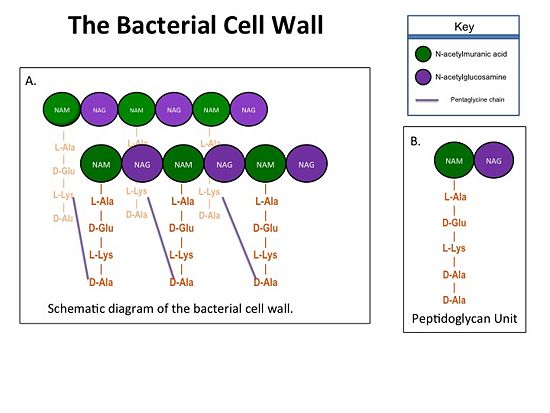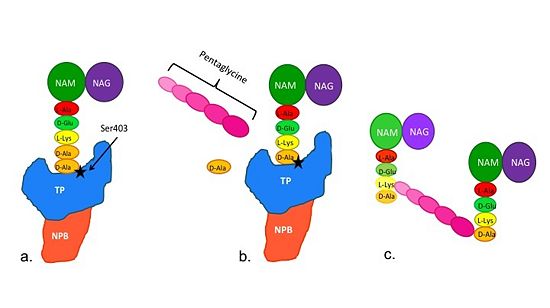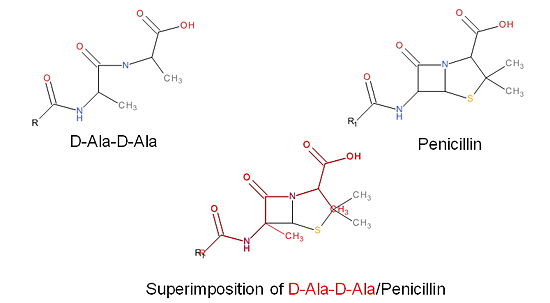Sandbox 127
From Proteopedia
(Difference between revisions)
| Line 1: | Line 1: | ||
| - | <StructureSection load= size=475 side='right' scene='36/365380/4dki_cartoon/ | + | <StructureSection load= size=475 side='right' scene='36/365380/4dki_cartoon/19'> |
Transpeptidase (TP), also known as penicillin-binding proteins (PBP), catalyze the cross-linking of peptidoglycan polymers during bacterial cell wall synthesis. Beta-lactam (β-lactam) antibiotics, which | Transpeptidase (TP), also known as penicillin-binding proteins (PBP), catalyze the cross-linking of peptidoglycan polymers during bacterial cell wall synthesis. Beta-lactam (β-lactam) antibiotics, which | ||
| Line 13: | Line 13: | ||
== Structure of a Resistant Transpeptidase == | == Structure of a Resistant Transpeptidase == | ||
| - | Methicillin resistant Staphylococcus aureus (MRSA) is resistant to all β-lactams because it acquires an alternative PBP, PBP2a, that is not bound or inhibited by any β-lactams. PBP2a is composed of two domains: a <font color='orange'><b>non-penicillin binding domain </b><scene name='36/365380/4dki_cartoon/ | + | Methicillin resistant Staphylococcus aureus (MRSA) is resistant to all β-lactams because it acquires an alternative PBP, PBP2a, that is not bound or inhibited by any β-lactams. PBP2a is composed of two domains: a <font color='orange'><b>non-penicillin binding domain </b><scene name='36/365380/4dki_cartoon/20'>(NPB) </scene></font> and a <font color='dodgerblue'><b>transpeptidase <scene name='36/365380/4dki_cartoon/21'>(TP)</scene> binding domain </b></font>. The NBP domain of PBP2a is anchored in the cell membrane, while the TP domain “sits” in the periplasm with its active site facing the inner surface of the cell wall. The active site contains <scene name='36/365380/Ser403/19'>a serine residue at position 403 (ser403)</scene> which catalyzes the cross-linking of the peptidoglycan rows with pentaglycine cross-links. |
| Line 42: | Line 42: | ||
MRSA becomes resistant to β-lactams by acquiring an alternative PBP, PBP2a, that is | MRSA becomes resistant to β-lactams by acquiring an alternative PBP, PBP2a, that is | ||
| - | neither bound nor inhibited by β-lactams. Recently, two cephalosporins – <scene name='36/365380/Ceftobiprole/ | + | neither bound nor inhibited by β-lactams. Recently, two cephalosporins – <scene name='36/365380/Ceftobiprole/23'>ceftobiprole</scene> and |
ceftaroline – that have anti-MRSA activity have been developed. Ceftobiprole is able to | ceftaroline – that have anti-MRSA activity have been developed. Ceftobiprole is able to | ||
inhibit PBP2a because additional chemical groups at the <scene name='36/365380/Ceftobiprole/12'>R2</scene> position of the cephalosporin backbone are able to interact with additional amino acid residues in PBP2a; specifically | inhibit PBP2a because additional chemical groups at the <scene name='36/365380/Ceftobiprole/12'>R2</scene> position of the cephalosporin backbone are able to interact with additional amino acid residues in PBP2a; specifically | ||
Revision as of 16:44, 15 August 2013
| |||||||||||



